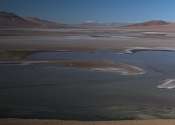Last update:
Astrobiology news

What can early Earth teach us about the search for life?
Earth is the only life-supporting planet we know of, so it's tempting to use it as a standard in the search for life elsewhere. But the modern Earth can't serve as a basis for evaluating exoplanets and their potential to ...
Astrobiology
1 hour ago
0
1

Webb telescope probably didn't find life on an exoplanet—yet
Recent reports of NASA's James Webb Space Telescope finding signs of life on a distant planet understandably sparked excitement. A new study challenges this finding, but also outlines how the telescope might verify the presence ...
Astrobiology
May 2, 2024
0
74

New findings point to an Earth-like environment on ancient Mars
A research team using the ChemCam instrument onboard NASA's Curiosity rover discovered higher-than-usual amounts of manganese in lakebed rocks within Gale Crater on Mars, which indicates that the sediments were formed in ...
Astrobiology
May 1, 2024
0
4666

Enceladus spills its guts through strike–slip motion
Over the course of its elliptical orbit, the moon Enceladus is squeezed unevenly by Saturn's gravitational pull and deforms from a spherical shape into a football shape and back again. This cyclic stress causes a phenomenon ...
Astrobiology
Apr 30, 2024
0
36

A NASA rover has reached a promising place to search for fossilized life on Mars
While we go about our daily lives on Earth, a nuclear-powered robot the size of a small car is trundling around Mars looking for fossils. Unlike its predecessor Curiosity, NASA's Perseverance rover is explicitly intended ...
Astrobiology
Apr 24, 2024
7
79

Will we know if TRAPPIST-1e has life?
The search for extrasolar planets is currently undergoing a seismic shift. With the deployment of the Kepler Space Telescope and the Transiting Exoplanet Survey Satellite (TESS), scientists discovered thousands of exoplanets, ...
Astrobiology
Apr 23, 2024
0
18

Why is methane seeping on Mars? NASA scientists have new ideas
The most surprising revelation from NASA's Curiosity Mars Rover—that methane is seeping from the surface of Gale Crater—has scientists scratching their heads.
Astrobiology
Apr 22, 2024
0
561

Look to deadly Venus to find life in the universe, new paper argues
Despite surface temperatures hot enough to melt lead, lava-spewing volcanoes, and puffy clouds of sulfuric acid, uninhabitable Venus offers vital lessons about the potential for life on other planets, a new paper argues.
Astrobiology
Apr 22, 2024
0
80

Crucial building blocks of life on Earth can more easily form in outer space, says new research
The origin of life on Earth is still enigmatic, but we are slowly unraveling the steps involved and the necessary ingredients. Scientists believe life arose in a primordial soup of organic chemicals and biomolecules on the ...
Astrobiology
Apr 21, 2024
1
1938

Unraveling water mysteries beyond Earth: Ground-penetrating radar will seek bodies of water on Jupiter
Finding water on distant planets and moons in our solar system is a challenge, especially when the instrument is thousands of kilometers away from the surface, but scientists presenting at the European Geosciences Union General ...
Astrobiology
Apr 19, 2024
1
98

Peptides on interstellar ice: Study finds presence of water molecules not a major obstacle for formation
A research team led by Dr. Serge Krasnokutski from the Astrophysics Laboratory at the Max Planck Institute for Astronomy at the University of Jena had already demonstrated that simple peptides can form on cosmic dust particles. ...
Astrobiology
Apr 17, 2024
0
158

Saturn's ocean moon Enceladus could support life—researchers are working out how to detect extraterrestrial cells there
Saturn has 146 confirmed moons—more than any other planet in the solar system—but one called Enceladus stands out. It appears to have the ingredients for life.
Astrobiology
Apr 17, 2024
0
42

New book gives insider's view of cosmic search for life
Whether life exists anywhere besides Earth is a burning question that, at long last, may soon be answered.
Astrobiology
Apr 16, 2024
1
22

In search for alien life, purple may be the new green
From house plants and gardens to fields and forests, green is the color we most associate with surface life on Earth, where conditions favored the evolution of organisms that perform oxygen-producing photosynthesis using ...
Astrobiology
Apr 16, 2024
6
127

Study shedding new light on Earth's global carbon cycle could help assess liveability of other planets
Research has uncovered important new insights into the evolution of oxygen, carbon, and other vital elements over the entire history of Earth—and it could help assess which other planets can develop life, ranging from plants ...
Astrobiology
Apr 10, 2024
0
86

Measuring the atmospheres of other worlds to see if there are enough nutrients for life
Life on Earth depends on six critical elements: carbon, hydrogen, nitrogen, oxygen, phosphorous, and sulfur. These elements are referred to as CHNOPS, and along with several trace micronutrients and liquid water, they're ...
Astrobiology
Apr 9, 2024
0
40

If life exists on Jupiter's moon Europa, scientists might soon be able to detect it
Europa is one of the largest of more than 90 moons in orbit around the planet Jupiter. It is also one of the best places to look for alien life.
Astrobiology
Apr 6, 2024
1
211

Why there may be oceans inside dwarf planets beyond Pluto—and what this means for the likely abundance of life
Earth was long thought to be the only planet in our solar system with an ocean, but it is beginning to look as though there are underground oceans inside even the most surprising icy bodies.
Astrobiology
Apr 4, 2024
0
50

Is the universe really a 'dark forest' full of hostile aliens in hiding?
We have no good reason to believe that aliens have ever contacted Earth. Sure, there are conspiracy theories and some rather strange reports about harm to cattle, but nothing credible. Physicist Enrico Fermi found this odd. ...
Space Exploration
Apr 4, 2024
4
80

Meteorites: Why study them? What can they teach us about finding life beyond Earth?
Universe Today has explored the importance of studying impact craters, planetary surfaces, exoplanets, astrobiology, solar physics, comets, planetary atmospheres, planetary geophysics, and cosmochemistry, and how this myriad ...
Astrobiology
Apr 1, 2024
0
11
More news

Could Earth life survive on a red dwarf planet?

NASA unveils design for message heading to Jupiter's moon Europa

Study finds the West is best to spot UFOs

Could tardigrades have colonized the moon?
Other news

Chimps shown to learn and improve tool-using skills even as adults

Research team discovers new property of light

Researchers 'unzip' 2D materials with lasers

New super-pure silicon chip opens path to powerful quantum computers

How a 'conductor' makes sense of chaos in early mouse embryos

Dogma-challenging telomere findings may offer new insights for cancer treatments

Decoding development: mRNA's role in embryo formation

Study sheds light on cancer cell 'tug-of-war'

Subglacial microbial life on Earth and beyond

Saturn's largest moon most likely uninhabitable

Boeing Starliner crewed mission postponed shortly before launch

Why parrots sometimes adopt—or kill—each other's babies

Rich molecular language guides tiny liquid droplet formation in cells

Microbiome studies help explore treatments for genetic disorders

Fruit fly model identifies key regulators behind organ development


















































